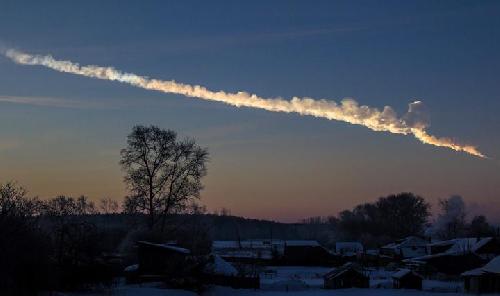On February 15th, 2013, as the approach of asteroid (367943) Duende was being closely monitored, something far more alarming happened. Duende approached the Earth was expected to pass nearly 27,700 km above the Earth's surface, well inside the boundaries of the ring of geosynchronous satellites but nearly perpendicular to it, but then the Chelyabinsk superbolide entry occurred, followed by the explosion and the fall of the large meteorite in the Russian Lake Chebarkul.
It caused damage to hundreds of buildings and injuries to nearly 1,500 people.
What was its origin? Three years and hundreds of published scientific studies later, we are still not close to knowing, but finding the precise value of its speed as it touched the top of the atmosphere appears to be the key to determine the orbit of the parent body of the Chelyabinsk superbolide.
Among these studies, there is a catalog of 960 video recordings published by the journal Astronomy&Astrophysics that includes material automatically recorded by security cameras, traffic cameras, dashcams - which are very popular in Russia- and manual recordings made with the video cameras and webcams of the many accidental witnesses.

The images and diverse scientific data compiled during the event have allowed the calculation of the atmospheric entry trajectory of the meteoroid, which turned into a meteor when it crossed Earth's atmosphere, exploding at a height of 20 km and releasing 500 kilotons or energy, approximately thirty times the yield of the Hiroshima nuclear bomb. The shockwave generated by such an explosion caused damage out to a distance of 75 miles breaking the windows, and even the window frames in some cases, of hundreds of buildings and injuring 1,491 people mainly due to cuts inflicted by shattered and broken glass.
Approximately five tons of meteoritic material reached the ground, including the 650-kg meteorite that was recovered by divers from the bottom of Lake Chebarkul.
At the beginning, it was thought that both events could be related and that the Chelyabinsk superbolide could have come from asteroid Duende itself or from a companion of this object, but when the orbits of both objects were analyzed and spectroscopic data of both asteroid Duende and the Chelyabinsk meteoritic material were studied in detail, the results obtained indicated that the two objects were completely independent and unrelated. It was a mere, albeit very unusual, coincidence in time of two spectacular cosmic events.
Where in space did the Chelyabinsk superbolide come from? For a while, it was thought that asteroid (86039) 1999 NC43 was a good candidate for the parent body of the Chelyabinsk superbolide but after the publication of a detailed international study in the journal Icarus, it became clear that the Chelyabinsk impactor and the PHA 86039 (1999 NC43) were not part of the same object; from a dynamical and compositional point of view the relationship between both objects is too weak.
During the last year, different orbital solutions for the asteroid that gave origin to the Chelyabinsk superbolide have been proposed in The Astrophysical Journal. These authors have used the recorded impact parameters of the Chelyabinsk superbolide to search for the orbit of its parent, or dynamically related, body by means of a numerical model validated using asteroid Duende's close approach data.
The results of the model suggest that asteroid 2011 EO40 is a good dynamical relative of the parent body of the Chelyabinsk superbolide although there is no spectroscopic evidence linking genetically 2011 EO40 to Chelyabinsk; at least not yet. The common origin of both celestial objects is a possibility that cannot be discarded using the currently available evidence. The results indicate that the Chelyabinsk impactor likely passed a gravitational keyhole on 1982 February 15 during a close encounter with our planet at a distance shorter than 0.0015 AU. As a result of this close encounter, the initial 2011 EO40-like trajectory of the Chelyabinsk meteoroid was changed into the one that drove the meteoroid to strike the Earth over three decades later.
Several other asteroids that have collided with the Earth in recent times, fortunately without fatal consequences, like 2008 TC3 in Sudan or 2014 AA in the Atlantic Ocean.




Comments